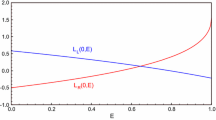Abstract
A quantum-mechanical system with spontaneously broken symmetry is considered, the effective potential is determined, and it is shown that with reduction of temperature the system undergoes a phase transition of the first kind.
Similar content being viewed by others
References
R. P. Feynman and A. R. Hibbs, Quantum Mechanics and Path Integrals, McGraw (1965).
C. W. Bernard, Phys. Rev.,9D, 3312 (1974).
L. Dolan and R. Jackiw, Phys. Rev.,9D, 3320 (1974).
D. A. Kirzhnits an A. Linde, Zh. Éksp. Teor. Fiz.,67, 1263 (1974); Physics of Elementary Particles and Inflation Cosmology [in Russian], Nauka, Moscow (1990).
Additional information
Yaroslavl State Technical University. Translated from Izvestiya Vysshikh Uchebnykh Zavedenii, Fizika, No. 6, pp. 111–114, June, 1995.
Rights and permissions
About this article
Cite this article
Zemskov, E.P. Finite-temperature effective potential of a system with spontaneously broken symmetry. Russ Phys J 38, 638–640 (1995). https://doi.org/10.1007/BF00559935
Received:
Issue Date:
DOI: https://doi.org/10.1007/BF00559935



